Using Code Generation to Create an SDK
Vinaya Mayya
Stephen Fuqua
Matthew Jackson
This section outlines how to use code generation to create an Ed-Fi ODS / API Client SDK using a Windows environment targeting C#.
ODS / API v7.1 metadata endpoints return documents adhering to the OpenApi v3.0.1 specification by default. A client can request OpenApi v2.0 metadata documents using the query string parameter version=2. OpenApi CodeGen can consume metadata in either version and generate the SDK. e.g.
https://api.ed-fi.org/v7.1/api/metadata/data/v3/swagger.json?version=2 for OpenApi v2.0
https://api.ed-fi.org/v7.1/api/metadata/data/v3/swagger.json?version=3 or https://api.ed-fi.org/v7.1/api/metadata/data/v3/swagger.json for OpenApi v3.0
The high-level steps are:
Each step is outlined in detail below.
Step 1. Install Latest Version of Java
If you don't already have Java installed, navigate to https://java.com/en/download/ and download the latest installer. Run the installer to install the latest version of Java. In case you're wondering: the code generation leverages Java, but it does output C# code.
Step 2. Download the OpenApi Codegen JAR File
Download the latest version of the OpenApi Codegen JAR 6.0.1. Windows users can use Invoke-WebRequest in PowerShell 3.0+.
Invoke-WebRequest -OutFile openApi-codegen-cli.jar https://repo1.maven.org/maven2/org/openapitools/openapi-generator-cli/6.6.0/openapi-generator-cli-6.6.0.jar
For more information and download options visit https://github.com/OpenAPITools/openapi-generator.
When generating an SDK using the OpenApi CodeGen resources in a language other than C# or Java and there are profiles defined in the OpenAPI specification file, be sure to verify that the proper contentTypes were created during the code generation.
Step 3. Generate the SDK Source Files
The SDK source files are generated using Swagger metadata via a few simple PowerShell commands. You can see the available metadata endpoints for SDK generation at https://api.ed-fi.org/v7.1/api/metadata?sdk=true.
java -jar <openapi-codegen-jar-file> generate -g csharp-netcore -i <target-swagger-json-file> --additional-properties targetFramework=net6.0,netCoreProjectFile=true --skip-validate-spec
A detailed description of the switch options can be found at https://github.com/OpenAPITools/openapi-generator.
To generate SDK source files, navigate to the folder containing openapi-codegen-cli.jar and run the following commands in PowerShell 3.0+ to generate C# SDK source files. You can use the unified SDK generation endpoints to combine resources, descriptors, and extensions under one namespace/directory in the generated SDK.
java -jar openApi-codegen-cli.jar generate -g csharp-netcore -i https://api.ed-fi.org/v7.1/api/metadata/data/v3/swagger.json --api-package Apis.All --model-package Models.All -o ./csharp --additional-properties packageName=EdFi.OdsApi.Sdk,targetFramework=net6.0,netCoreProjectFile=true --global-property modelTests=false --global-property apiTests=false --skip-validate-spec
java -jar openApi-codegen-cli.jar generate -g csharp-netcore -i https://api.ed-fi.org/v7.1/api/metadata/data/v3/ed-fi/swagger.json --api-package Apis.All --model-package Models.All -o ./csharp --additional-properties packageName=EdFi.OdsApi.Sdk,targetFramework=net6.0,netCoreProjectFile=true --global-property modelTests=false --global-property apiTests=false --skip-validate-spec
Alternatively, you can generate SDK with segregated namespaces for resources, descriptors, enrollment composites, and Identity API endpoints as follows:
java -jar openApi-codegen-cli.jar generate -g csharp-netcore -i https://api.ed-fi.org/v7.1/api/metadata/data/v3/resources/swagger.json --api-package Api.Resources --model-package Models.Resources -o ./csharp --additional-properties packageName=EdFi.OdsApi.Sdk,targetFramework=net6.0,netCoreProjectFile=true --global-property modelTests=false --global-property apiTests=false --skip-validate-spec java -jar openApi-codegen-cli.jar generate -g csharp-netcore -i https://api.ed-fi.org/v7.1/api/metadata/composites/v1/ed-fi/enrollment/swagger.json --api-package Api.EnrollmentComposites --model-package Models.EnrollmentComposites -o ./csharp --additional-properties packageName=EdFi.OdsApi.Sdk,targetFramework=net6.0,netCoreProjectFile=true --global-property modelTests=false --global-property apiTests=false --skip-validate-spec java -jar openApi-codegen-cli.jar generate -g csharp-netcore -i https://api.ed-fi.org/v7.1/api/metadata/identity/v2/swagger.json --api-package Api.Identities --model-package Models.Identities -o ./csharp --additional-properties packageName=EdFi.OdsApi.Sdk,targetFramework=net6.0,netCoreProjectFile=true --global-property modelTests=false --global-property apiTests=false --skip-validate-spec java -jar openApi-codegen-cli.jar generate -g csharp-netcore -i https://api.ed-fi.org/v7.1/api/metadata/data/v3/descriptors/swagger.json --api-package Api.Descriptors --model-package Models.Descriptors -o ./csharp --additional-properties packageName=EdFi.OdsApi.Sdk,targetFramework=net6.0,netCoreProjectFile=true --global-property modelTests=false --global-property apiTests=false --skip-validate-spec
Wait for the Swagger CodeGen to finish generating code. A Visual Studio Solution named EdFi.OdsApi.Sdk.sln will be created with the SDK artifacts.
Step 4. Use the SDK in a Sample C# Program
- Open EdFi.OdsApi.Sdk.sln in Visual Studio.
- Right-click on the solution and click Restore NuGetPackages.
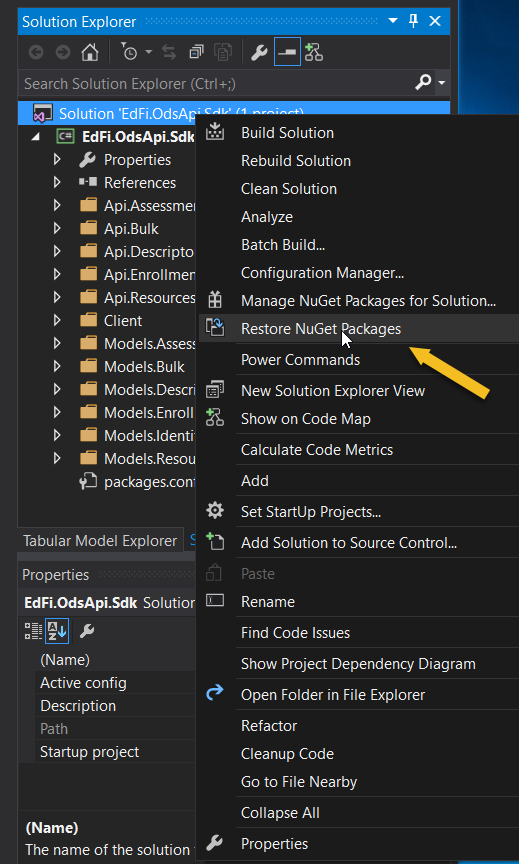
- Build the solution.
- Right-click on the solution and add a new project. Choose the type Console App. Name the project EdFi.OdsApi.SdkClient.
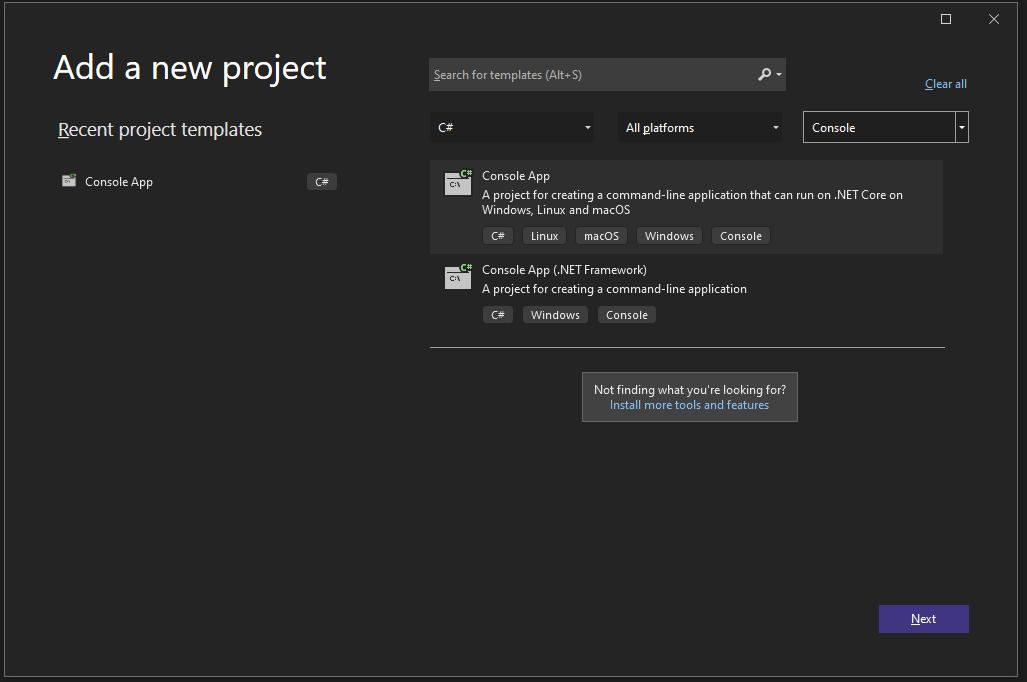

Right-click on Edfi.OdsApi.SdkClient > Set as Startup Project.

In Solution Explorer, right-click EdFi.OdsApi.SdkClient Dependencies node and click Add Project Reference.
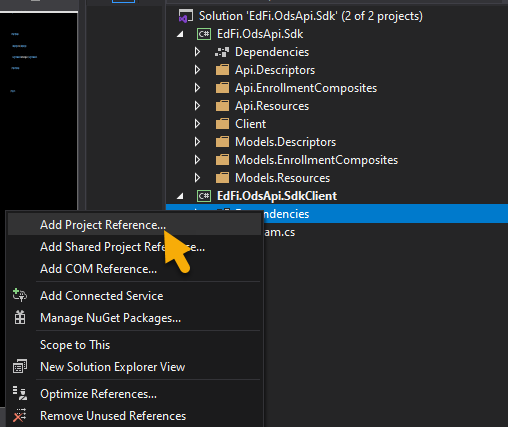
In the Add Reference > Projects tab select EdFi.OdsApi.Sdk, and then click OK.
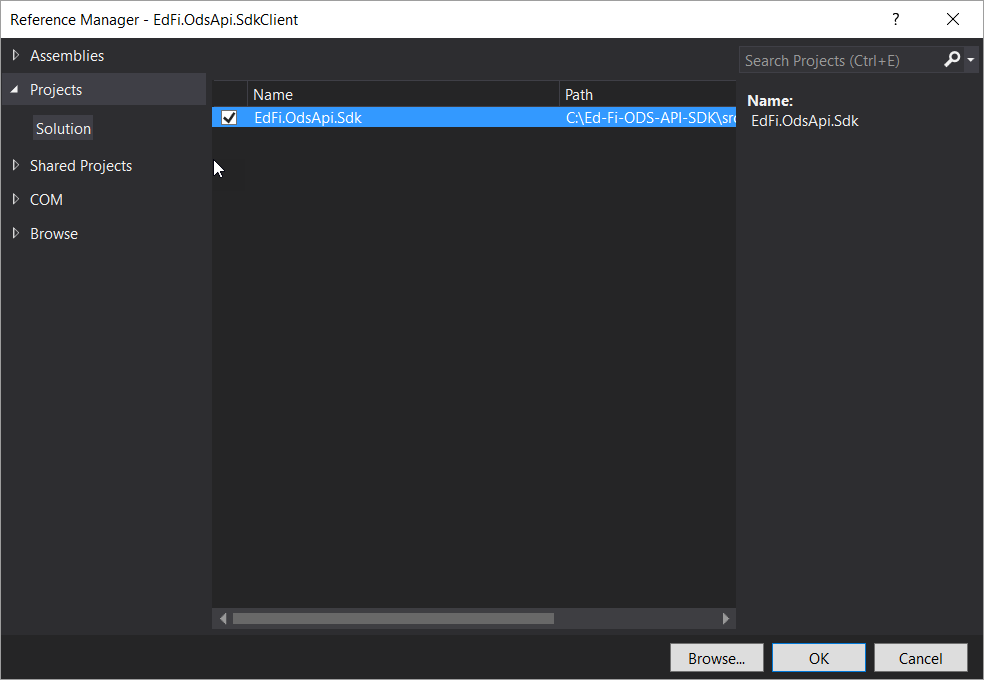
- In Solution Explorer, right-click EdFi.OdsApi.SdkClient Dependencies node and click Manage Nuget Packages... and add RestSharp reference, install the same version that EdFi.OdsApi.Sdk has.
Open the Program.cs file and add the following
usingstatements at the top of the file:using EdFi.OdsApi.Sdk.Apis.All; using EdFi.OdsApi.Sdk.Client; using EdFi.OdsApi.Sdk.Models.All; using EdFi.OdsApi.SdkClient;
Edit the Program.cs file and paste the following code. The client and key are using a publicly available sandbox environment with sample data hosted by the Ed-Fi Alliance.
// Trust all SSL certs -- needed unless signed SSL certificates are configured. System.Net.ServicePointManager.ServerCertificateValidationCallback = ((sender, certificate, chain, sslPolicyErrors) => true); //Explicitly configures outgoing network calls to use the latest version of TLS where possible. //Due to our reliance on some older libraries, the.NET framework won't necessarily default //to the latest unless we explicitly request it. Some hosting environments will not allow older versions //of TLS, and thus calls can fail without this extra configuration. System.Net.ServicePointManager.SecurityProtocol |= System.Net.SecurityProtocolType.Tls11 | System.Net.SecurityProtocolType.Tls12; // Oauth configuration var oauthUrl = "https://api.ed-fi.org/v7.1/api/"; var clientKey = "RvcohKz9zHI4"; var clientSecret = "E1iEFusaNf81xzCxwHfbolkC"; // TokenRetriever makes the oauth calls. It has RestSharp dependency, install via NuGet var tokenRetriever = new TokenRetriever(oauthUrl, clientKey, clientSecret); // Plug Oauth access token. Tokens will need to be refreshed when they expire var configuration = new Configuration() { AccessToken = tokenRetriever.ObtainNewBearerToken(), BasePath = "https://api.ed-fi.org/v7.1/api/data/v3" }; // GET students var apiInstance = new StudentsApi(configuration); apiInstance.Configuration.DefaultHeaders.Add("Content-Type", "application/json"); // Fetch a single record with the totalCount flag set to true to retrieve the total number of records available var studentWithHttpInfo = apiInstance.GetStudentsWithHttpInfo(limit: 1, offset: 0, totalCount: true); var httpReponseCode = studentWithHttpInfo.StatusCode; // returns System.Net.HttpStatusCode.OK Console.WriteLine("Response code is " + httpReponseCode); // Parse the total count value out of the "Total-Count" response header int.TryParse(studentWithHttpInfo.Headers["Total-Count"].First(), out var totalCount); int offset = 0; int limit = 100; var students = new List<EdFiStudent>(); while (offset < totalCount) { Console.WriteLine($"Fetching student records {offset} through {Math.Min(offset + limit, totalCount)} of {totalCount}"); students.AddRange(apiInstance.GetStudents(limit: limit, offset: 0)); offset += limit; } Console.WriteLine(); Console.WriteLine("Student Results"); foreach (var student in students) { Console.WriteLine($"Student: {student.StudentUniqueId}, {student.FirstName}, {student.LastSurname}"); } Console.WriteLine(); Console.WriteLine("Hit ENTER key to continue..."); Console.ReadLine();Add a .cs file named TokenRetriever.cs and copy the following code to help with OAuth integration.
using System.Net; using System.Runtime.Serialization; using System.Security.Authentication; using EdFi.OdsApi.Sdk.Client; namespace EdFi.OdsApi.SdkClient { public class TokenRetriever { private string oauthUrl; private string clientKey; private string clientSecret; public TokenRetriever(string oauthUrl, string clientKey, string clientSecret) { this.oauthUrl = oauthUrl; this.clientKey = clientKey; this.clientSecret = clientSecret; } public string ObtainNewBearerToken() { var oauthClient = new ApiClient(oauthUrl); return GetBearerToken(oauthClient); } private string GetBearerToken(ApiClient oauthClient) { var configuration = new Configuration() { BasePath = oauthUrl }; var bearerTokenRequestOptions = new RequestOptions() { Operation = String.Empty }; bearerTokenRequestOptions.FormParameters.Add("client_id", clientKey); bearerTokenRequestOptions.FormParameters.Add("client_secret", clientSecret); bearerTokenRequestOptions.FormParameters.Add("grant_type", "client_credentials"); var bearerTokenResponse = oauthClient.Post<BearerTokenResponse>("oauth/token", bearerTokenRequestOptions, configuration); if (bearerTokenResponse.StatusCode != HttpStatusCode.OK) { throw new AuthenticationException("Unable to retrieve an access token. Error message: " + bearerTokenResponse.Data.Error); } if (bearerTokenResponse.Data.Error != null || bearerTokenResponse.Data.TokenType != "bearer") { throw new AuthenticationException( "Unable to retrieve an access token. Please verify that your application secret is correct."); } return bearerTokenResponse.Data.AccessToken; } } [DataContract] internal class BearerTokenResponse { [DataMember(Name = "access_token", EmitDefaultValue = false)] public string AccessToken { get; set; } [DataMember(Name = "expires_in", EmitDefaultValue = false)] public string ExpiresIn { get; set; } [DataMember(Name = "token_type", EmitDefaultValue = false)] public string TokenType { get; set; } [DataMember(Name = "error", EmitDefaultValue = false)] public string Error { get; set; } } }- Build the project and run it without debugging (Ctrl+F5) and you should see the following results:
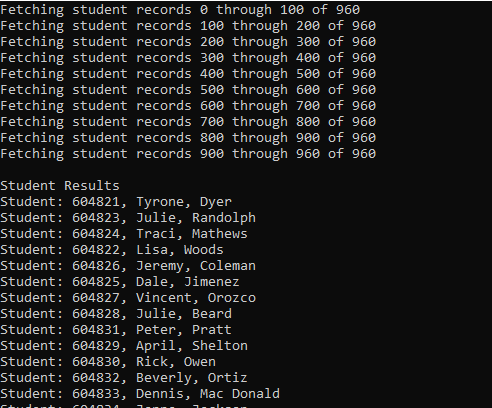
With that, you're done!
This exercise leveraged a publicly available instance of the API, which contains the surface for a core implementation. If you're working with a specific platform host, a great next step is to use these same techniques to generate an SDK for that platform. If the platform host has extended the data model, your new code will automatically include those structures in the data access components in the generated code.
The following link is a ZIP archive containing a C# sample program that uses the client SDK:
The Sample program works against the Ed-Fi ODS / API sandbox hosted at https://api.ed-fi.org/v7.1/docs/.